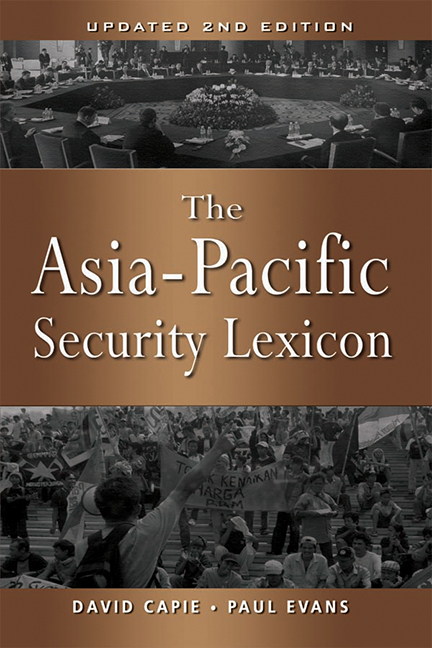Book contents
- Frontmatter
- Contents
- Abbreviations
- Introduction to the Second Edition
- Ad Hoc Multilateralism
- A la Carte Multilateralism
- The “ASEAN Way”
- Balance of Power
- Bilateralism
- Coalition of the Willing
- Coercive Diplomacy
- Collective Defence
- Collective Security
- Common Security
- Comprehensive Security
- Concert of Powers
- Concerted Unilateralism
- Confidence-Building Measures
- Confidence- and Security-Building Measures
- Constructive Intervention
- Cooperative Security
- Engagement
- Flexible Consensus
- Human Security
- Humanitarian Intervention
- Middle Power
- Multilateralism
- Mutual Security
- New Security Approach
- Non-Traditional Security
- Open Regionalism
- Peaceful Rise
- Pre-emption and Preventive War
- Preventive Diplomacy
- Security Community
- Terrorism
- Track One
- Track One-and-a-Half
- Track Two
- Track Three
- Transparency
- Trust-Building Measures
- About the Authors
Comprehensive Security
Published online by Cambridge University Press: 21 October 2015
- Frontmatter
- Contents
- Abbreviations
- Introduction to the Second Edition
- Ad Hoc Multilateralism
- A la Carte Multilateralism
- The “ASEAN Way”
- Balance of Power
- Bilateralism
- Coalition of the Willing
- Coercive Diplomacy
- Collective Defence
- Collective Security
- Common Security
- Comprehensive Security
- Concert of Powers
- Concerted Unilateralism
- Confidence-Building Measures
- Confidence- and Security-Building Measures
- Constructive Intervention
- Cooperative Security
- Engagement
- Flexible Consensus
- Human Security
- Humanitarian Intervention
- Middle Power
- Multilateralism
- Mutual Security
- New Security Approach
- Non-Traditional Security
- Open Regionalism
- Peaceful Rise
- Pre-emption and Preventive War
- Preventive Diplomacy
- Security Community
- Terrorism
- Track One
- Track One-and-a-Half
- Track Two
- Track Three
- Transparency
- Trust-Building Measures
- About the Authors
Summary
One of the most widely used security concepts in the Asia-Pacific region. According to Muthiah Alagappa, the term was first formally coined in Japan during the Ohira Administration in the 1970s. It has also been widely used by several governments in Southeast Asia, particularly Indonesia, Malaysia, and Singapore. Since the end of the Cold War, interest in inclusive approaches to security has spread to other parts of the Asia-Pacific region. For example, Mongolia's concept of national security, which was officially articulated in 1994, also embraces much of the substance of comprehensive security.
The central premise of comprehensive security is that security must be conceived in a holistic way — to include both military and non-military threats to a state's overall well-being. The concept also stresses the importance of non-military policy responses. Like many security concepts, however, the term “comprehensive security” is used and interpreted in very different ways in different parts of the region.
The Japanese interpretation of “comprehensive national security” (Soogoo anzen hoshoo) was developed as an alternative to the concept of “national security” which within Japan was widely associated with the period of wartime expansionism and aggression. Following a series of government studies on the subject, the “Report on Comprehensive National Security” was submitted to the government of Acting Prime Minister Masayoshi Ito in July 1980. The so-called Inoki Report defined security in a very broad way: it stressed the need to maintain military preparedness and alliances, identified the less orthodox goals of attaining energy and food security, and also set out measures for dealing with major earthquakes. At the core of the Japanese idea of comprehensive security lies the multidimensional nature of contemporary threats: challenges to a state can come in the form of economic problems, the disruption of trade or natural disasters, as well as from an armed enemy.
In stressing the multidimensional nature of threats, the Japanese interpretation of comprehensive security recognizes that military power, in itself, is not sufficient to guarantee a nation's security. It emphasizes a wide variety of non-military policy responses including the full use of political, economic, diplomatic, and military resources.
- Type
- Chapter
- Information
- The Asia-Pacific Security Lexicon (Upated 2nd Edition) , pp. 65 - 76Publisher: ISEAS–Yusof Ishak InstitutePrint publication year: 2007



